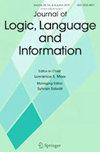联合与相对群公告逻辑
IF 0.6
3区 数学
Q4 COMPUTER SCIENCE, ARTIFICIAL INTELLIGENCE
引用次数: 9
摘要
本文章由计算机程序翻译,如有差异,请以英文原文为准。
Coalition and Relativised Group Announcement Logic
求助全文
通过发布文献求助,成功后即可免费获取论文全文。
去求助
来源期刊

Journal of Logic Language and Information
COMPUTER SCIENCE, ARTIFICIAL INTELLIGENCEL-LOGIC
CiteScore
1.70
自引率
12.50%
发文量
40
期刊介绍:
The scope of the journal is the logical and computational foundations of natural, formal, and programming languages, as well as the different forms of human and mechanized inference. It covers the logical, linguistic, and information-theoretic parts of the cognitive sciences.
Examples of main subareas are Intentional Logics including Dynamic Logic; Nonmonotonic Logic and Belief Revision; Constructive Logics; Complexity Issues in Logic and Linguistics; Theoretical Problems of Logic Programming and Resolution; Categorial Grammar and Type Theory; Generalized Quantification; Information-Oriented Theories of Semantic Structure like Situation Semantics, Discourse Representation Theory, and Dynamic Semantics; Connectionist Models of Logical and Linguistic Structures. The emphasis is on the theoretical aspects of these areas.
 求助内容:
求助内容: 应助结果提醒方式:
应助结果提醒方式:


